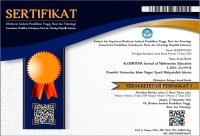PENINGKATAN KEMAMPUAN MATEMATIS SISWA MELALUI PENDEKATAN PENDIDIKAN MATEMATIKA REALISTIK
Abstract
In general, junior high school students learn mathematics with an inductive pattern. However, the statements in mathematics are obtained through a deductive mindset. Therefore we need a learning approach that can accommodate students' thinking patterns. Mathematics adheres to the law of consistency which causes the structure of material in mathematics to be hierarchically arranged, interrelated, and has characteristics that have implications for determining strategies, approaches and the use of learning media. This article aims to review the theory of the Realistic Mathematics Education Approach (PMR). An approach that can make students involved in building their own concepts and models used through problem solving. The PMR discussion begins with the definition of PMR, the principles and characteristics of PMR, and the contribution of PMR in learning mathematics. Writing this article uses the literature review method which consists of books, journal articles, and other documents related to the topic of discussion. The results of the study found that Realistic Mathematics Education (PMR) is a mathematics learning innovation that is in accordance with the 2013 curriculum.The use of contexts and models, as well as the use of student contributions through discussions to discuss various linkages between mathematics material, makes this approach able to contribute to improving five general mathematical abilities. which includes: the ability to understand mathematics, problem solving, mathematical connections, mathematical communication, and mathematical reasoning.
Keywords
Pendidikan matematika realistik, pembelajaran matematika, kemampuan matematis siswa
DOI: 10.15408/ajme.v2i2.17819
Refbacks
- There are currently no refbacks.












